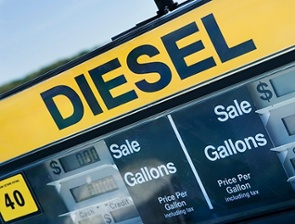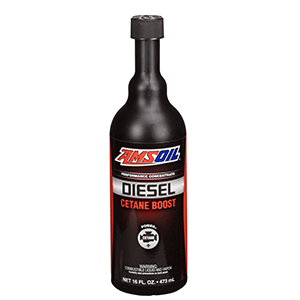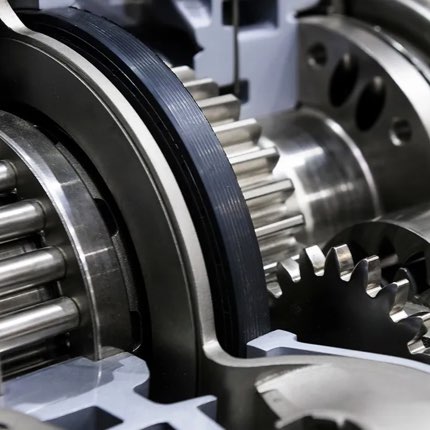In the same way octane indicates the ignition stability of gasoline, cetane values are assigned to diesel fuel to rate its combustion quality.
Cetane numbers are used to indicate the combustion speed of diesel fuel. Diesel fuels with higher cetane ratings have shorter ignition delays, providing more complete combustion and allowing engines to operate more effectively.
We asked mechanical engineer Mark Nyholm, AMSOIL Product Manager – Heavy Duty, to elaborate on the importance of understanding cetane and why AMSOIL carries Diesel Cetane Boost in its diesel products line.

If diesel engines operate better with higher cetane values, why is most diesel fuel only between 40 and 45?
Mark Nyholm: This is a really great question and I believe it comes down to economics from the perspective of the fuel refinery.
If the crude oil they have will provide a cetane value of, let’s say, 40 and today’s engines run at optimum efficiency with a cetane value of 48, what incentive does the refinery have to improve the cetane value? Will the market bear the increased per-gallon cost of diesel if the refinery adds cetane improver? The answers are “none” and “not really.”
Most diesel owners don’t have a clue what cetane does for them let alone the appropriate number for their engine.
Since diesel cetane value is not published at the pump, most diesel owners simply know they need to pull the green-handled ULSD pump and fill up the tank.
The limit was set so that all fuels could reasonably achieve this minimum 40 number without adding a bunch of cetane improver to it. That value, I also imagine, was determined by the Engine Manufacturers Association to be “acceptable” for operation, even though not ideal.
How does increased diesel cetane reduce smoke and emissions and improve fuel economy?
Nyholm: Cetane number is a measure of combustion efficiency. The higher the number, the better potential for each and every droplet that is sprayed into the combustion chamber to burn and produce power.
The more efficiently the fuel burns in the combustion chamber, the less possibility to produce smoke and byproducts of combustion that the exhaust after-treatment system must manage.
The more of that fuel that burns, the better power output and better possible fuel mileage you can expect to achieve from the engine.
For whom is AMSOIL Diesel Cetane Boost designed? OTR truckers or diesel-truck enthusiasts?
Nyholm: Typically enthusiasts buy cetane improvers. Now, you will find enthusiasts in about every market out there, so it’s hard to narrow down which market buys the most in volume.
If I were to guess, I’d say the two most popular applications that use cetane improvers are turbodiesel pickups and class 8 OTR trucks.
Updated. Originally published: March 21, 2018.







I’ve used both of Amsoils additives. The cetane booster, and the booster\cleaner combined. I saw absolutely NO difference in the economy of my pickup. I’m not a racer, or high performance chaser, I was just hoping for some better fuel economy. I drive pretty conservatively, and am disappointed, both in the fact that the Amsoil product resulted in no improvement. But also, in the fact that my new 2016 Silverado, gives me the exact same fuel economy as my 2008 did. I would have expected some improvements during an 8 year time span. But I seem stuck at 18 mpg on long distance trips, and 14 mpg in town.
Hi Pete,
We focus on providing the best diesel fuel additives available for injector cleaning; added lubricity for the fuel pump and injectors; better cold-flow properties; prevention of wax settling during storage; better combustion efficiency; easier starting; smoother idle; maximum horsepower; added corrosion protection and longer fuel-filter life.
That is a long list of performance improvements. Our diesel additives also provide increased fuel economy to like-new performance. In most situations, however, they cannot provide better fuel economy compared to when the vehicle was new. There are many factors that control fuel economy, from your right foot, to ambient temperatures, to wind direction, to tire pressure and so on.
We’re sorry you don’t like the fuel economy of your 2016 Silverado, but that’s a function of GM and out of our control. Today’s turbodiesel pickups seem headed toward increased horsepower and torque, with little respect to fuel economy. Hence the reason your new truck makes a heck of a lot more power than your older one and still gets the same mileage.
The goal of our additives is to provide your fuel system and engine with protection from prematurely wearing out, which ends up costing you thousands. We hope you decide to continue using our additives on a maintenance dose recommendation. You’ll be giving your truck what it needs for a long and happy life.
Thanks,
John
Why does AmsOil not include compliance data for Diesel powered agricultural tractors and equipment?
For example, the John Deere CK-4 oil in synthetic 0W40 is the recommended engine oil after break-in on JD specific 10W30 oil. An alternative is 15W40 – depending on their temperature chart. None of Deere oils are API labelled as far as I know.
So, our new 2017 JD tractor will need to come off break-in oil later, after 1 year or 500 hours.
Now the real issue: JD warrants it engine oil & oil filters for 500 operating hours, BUT ONLY IF USING JD BRANDED OIL AND FILTERS, while under warranty and beyond. Dealer suggests using all JD lubes and filters during the warranty period to avoid challenges in the event of a failure.
Are AmsOil Diesel CK-4 oils qualified oils acceptable to meet JD specifications?
Hi Roger,
AMSOIL Signature Series Max-Duty Synthetic Diesel Oil meets and exceeds the JD specifications. Please make sure you are reading the owner’s manual correctly. JD will warrant its oil and filter to last 500 hours in its engines, that is correct. They legally cannot withhold warranty on their engine if you use an equal or better product to JD out to 500 hours. As long as you document the oil purchase and maintenance history, that is what JD will want to see in the event of any sort of failure under warranty. That is not uncommon to any equipment manufacturer.
Thanks.
I own a 2015 Chevy Duramax 2500HD 4×4 truck. I’ve been an Amsoil user and dealer since 1985. Like all my vehicles from my truck to Motor home, atv, suv, chainsaws, lawn tractors, I use amsoil oil & fuel stabilizers and performance improvers. My truck now havs 80,000 miles and gets anywhere from 14 mpg in town to 22.8 (my best) going unloaded and approx. 14 mpg loaded with trailer loaded, all depending on wind and altitude. I’ve ran nothing except AMSOIL 15w40 in my truck since breakin miles. I live in the Texas panhandle at 3800 ft elevation. I travel weekly to my farm 115 miles south and it changes to about 1200 ft elevation. Sometimes I get 22 mpg going down and only 15 coming back home, depending on our winds. I cannot say how much the 3 in 1 diesel additive improves my mileage but, I use it about every 4th tankful whether I need it or not because my past experience as a Mechanic and shop owner, I’ve seen a lot of fuel related problems due to the poor fuel quality these days. The old saying ” An ounce of prevention is worth a pound of cure” is my belief today and has been a long time. I made a very good living repairing vehicles of all types because of lack of maintenance and no preventative maintenance by people. My last service truck had over 200,000 miles on it when I retired and It never had anything but Amsoil products used in the crankcase. I am a firm beliver in Amsoil products.
Hi Michael,
Thanks for sharing your great experiences with our products. We also love to hear from satisfied customers.
Thanks for your loyalty,
John
Yes, it is pure economy. Cetane can be easily eastimated by an app one can find at https://rjpatelioc-petroleum.blogspot.com/2020/01/app-for-calculated-cetane-index-cci_19.html
I believe in using the correct oil recommended by the engine manufacturer (at the time of Mfg.) and not go by what is currently \ typically available at my local auto store. I have a JD tractor that was Mfg. right before the introduction of the current emissions standards that seem to “demand” CK-4 oils or the new FA oils. The manual states that API CH-4 oils or newer can be used. I have used AMSOIL synthetic 10W-30/SAE 30 Diesel (ACD) up until you stopped selling it. The (ACD) oil had an API rating of CI-4+ / SL which I could use in my diesel tractor and any of my small gas engines that specify a W-30 API rating. The reason I had chosen to use this oil was because of the higher zinc, phosphorus and TBN levels that I felt was required because of the engines having flat tappet cams. It seems that now this oil is becoming harder to come by and any reference to any modern oil now only has the API CK-4 or FA rating and no “S” rating. The additives in the older oils is what made it compatible with the “engine”. I do not believe in the API backward compatibility ratings once the CJ-4+ oils were replaced by the CK-4 oils, because that is when the API SL/SN/SM ratings were dropped in newer diesel oils. At some point I will be forced to use the latest modern motors oils and add an additive to replace what limited levels of zinc and phosphorus are currently in use. Secondly, why is it that most new oils do not state what group base oils are being used.